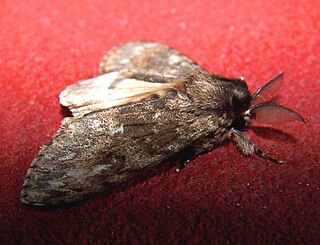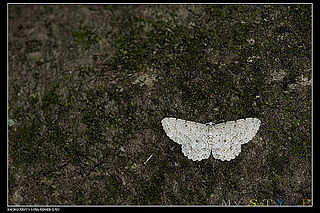Related Research Articles

Dordura is a monotypic moth genus of the family Noctuidae erected by Frederic Moore in 1882. Its only species, Dordura aliena, was first described by Francis Walker in 1865. It is found in the Indian subregion, Sri Lanka, Myanmar, Thailand, Peninsular Malaysia, Sumatra, Borneo and New Guinea.

Ercheia cyllaria is a species of moth of the family Erebidae first described by Pieter Cramer in 1779. It is found in the Indian subregion, Sri Lanka, Taiwan, Japan, Indochina, Thailand, Peninsular Malaysia, Sumatra, Borneo, Seram and the Kai Islands.
Ulotrichopus rama is a moth of the family Erebidae first described by Frederic Moore in 1885. It is found on Sumatra, Flores and Sri Lanka.

Ctenoplusia limbirena, the Scar Bank gem, or silver U-tail, is a moth of the family Noctuidae. It is found in south-western Europe, Africa, the Canary Islands, Arabia, the southern Himalayas, India, Sri Lanka, Indochina to south-eastern China, Taiwan, Sulawesi, Bali and Timor. In New Zealand, it has been established since 2011.
Anoratha paritalis is a moth of the family Erebidae. It was first described by Francis Walker in 1859 and is found in Sri Lanka.
Hypena iconicalis is a moth in the family Noctuidae first described by Francis Walker in 1859. It is found in India, Sri Lanka, Taiwan, Papua New Guinea and Fiji.

Hypena lignealis is a moth in the family Noctuidae described by Francis Walker in 1866. It is found in Sri Lanka, Taiwan and Japan.

Hydrillodes lentalis is a species of moth of the family Erebidae described by Achille Guenée in 1854. It is found in south-east Asia and Australia (Queensland).

Scirpophaga incertulas, the yellow stem borer or rice yellow stem borer, is a species of moth of the family Crambidae. It was described by Francis Walker in 1863. It is found in Afghanistan, Nepal, north-eastern India, Sri Lanka, Bangladesh, Myanmar, Vietnam, Thailand, Malaysia, Singapore, Sumatra, Java, Borneo, Sumba, Sulawesi, the Philippines, Taiwan, China and Japan.
Lamoria adaptella, the plain lamoria, is a species of snout moth in the genus Lamoria. It was described by Francis Walker in 1863 and is known from South Africa, the Gambia, Kenya, Mozambique, India, Sri Lanka, Indonesia and Singapore, as well as Japan and Taiwan.
Scopula ferruginea is a moth of the family Geometridae. It was described by George Hampson in 1893. It is endemic to Sri Lanka.

Scopula fibulata is a moth of the family Geometridae first described by Achille Guenée in 1858. It is found in Kenya, Sri Lanka and China.

Lymantria serva, the ficus tussock moth or serva tussock moth, is a moth in the family Erebidae. It was described by Johan Christian Fabricius in 1793 and is found in Nepal, Sri Lanka, Assam in India and Yunnan in China. It is possibly also found in Taiwan and Hongkong, but these records might be Lymantria iris.
Collix hypospilata is a moth in the family Geometridae. It was described by Achille Guenée in 1857. It is endemic to Sri Lanka.
Gymnoscelis deleta is a moth in the family Geometridae. It is found in India, Korea, Japan, Taiwan and probably in Sri Lanka according to Hampson.
Iambia thwaitesii is a moth of the family Noctuidae first described by Frederic Moore in 1885.

Harita rectilinea is a moth of the family Noctuidae described by Frederic Moore in 1882. It is found in India, Sri Lanka, Myanmar, Peninsular Malaysia and on Sumatra and Borneo.

Catoria sublavaria is a moth of the family Geometridae described by Achille Guenée in 1857. It is found in the tropics of India, Sri Lanka, Myanmar, towards New Guinea, to the Bismarck Islands and Taiwan.
Helcystogramma philomusum is a moth in the family Gelechiidae. It was described by Edward Meyrick in 1918. It is found in Sri Lanka and north-eastern India.

Feliniopsis indistans is a moth of the family Noctuidae first described by Achille Guenée in 1852. It is found in India, Sri Lanka, Hong Kong, Japan and Taiwan.
References
- ↑ "Species Details: Trisula variegata Moore, 1858". Catalogue of Life. Retrieved 29 May 2018.
- ↑ Koçak, Ahmet Ömer & Kemal, Muhabbet (20 February 2012). "Preliminary list of the Lepidoptera of Sri Lanka". Cesa News (79). Centre for Entomological Studies Ankara: 1–57 – via Academia.
- ↑ "Trisula variegata Moore, 1858". みんなで作る日本産蛾類図鑑[An Identification Guide of Japanese Moths Compiled by Everyone] (in Japanese). Retrieved 28 March 2018.